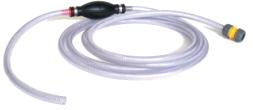 Using WaterGreen
Using WaterGreen
WaterGreen (aka Droughtbuster) is supplied with a two-sided printed A4 sheet of instructions for use and helpful tips. Using the syphon was very easy – a few slow squeezes to fill the syphon bulb with water, and then seven or eight quick squeezes to pump water up the tube to the height of the bathroom window (in our experiments 140 cm above the height of the bottom of the bath) and below the height of the bottom of the bath outside. After that water continued to be sucked out of the bath through the tube and into hosepipe with no further pumping required.
From our upstairs bathroom a bath filled with around 60 litres of water was completely emptied in just a few minutes which was very impressive.
WaterGreen with Porous Pipe Irrigation
Ideally greywater should not be stored for more than a few hours (unless it goes through some kind of greywater filtration and/or disinfection first). When stored in warm conditions greywater will quickly begin to smell bad and dangerous disease-inducing pathogens can develop.
Greywater should really be used in sub-soil irrigation systems, or any other irrigation in which the water does not pool on the surface. Where porous pipe irrigation is used on the surface of the garden, a good layer of mulch should always be used to cover the pipes. Surface pools of greywater rapidly turn into a bacteria soup in warm weather attracting both flies and splashing children. Greywater should NEVER be sprayed or used in a sprinkler.
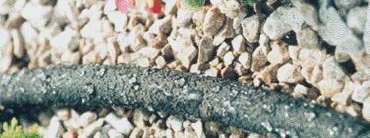
With these points in mind, we next connected the WaterGreen directly to a porous pipe system used to irrigate well-mulched flower beds. (Remember that greywater must not be used to water edible plants. Use rainwater for veggies, fruits, and herbs etc.) Obviously the water emptied from the bath far more slowly as its progress was restricted by the porous pipe, however the bath emptied in the end and the beds were successfully watered. As an added bonus, this gave the bathwater time to cool down so it is better for the plants.
WaterGreen Filter
Using the WaterGreen regularly for porous pipe irrigation, the tiny holes in the pipe would soon get blocked up with hair and soap scum from the bath. It would therefore be wise to secure a thin piece of wide-meshed muslin or any other filter cloth over the end of WaterGreen which goes into the bath so that the nasties never get into the system at all. We tried it with a threadbare old tea towel and the syphon still worked.
NEW Pictured below is the new net filter and securing ring which will be supplied with new purchases of WaterGreen. Some stock is still being sent out with the filter, however the net will be sent out free of charge to customers if required.
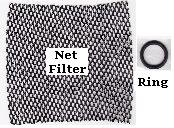
The net is simply wrapped around the bath-end of the WaterGreen and secured with the supplied rubber ring.
Using WaterGreen in a Bungalow
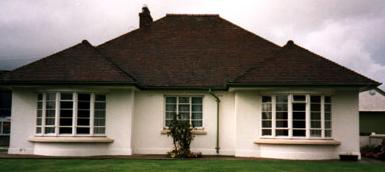
According to the official WaterGreen website (droughtbuster.co.uk), WaterGreen needs the bottom of the bath to be at least 60cm higher than the water-out end of the hosepipe in the garden. There are many bungalows and ground floor flats which have exactly this kind of a height differential between bath and garden and so we tested the speed at which water is emptied from a bath at different bungalow-type heights: 40cm, 60cm, and 120cm.
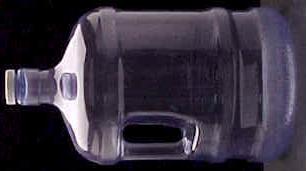
A ten metre length of hosepipe was attached to WaterGreen and hung out of the bathroom window of a bungalow. The end of the hosepipe was then held over the top of an empty five litre bottle (1/15 of a typical 75 litre bath) at the three different heights to be measured. A digital stopwatch was used to measure the time taken to fill the bottle to the brim with used bathwater syphoned via WaterGreen.
| Height Above Bottom of Bath |
Time to Fill 5 Litre Bottle |
| 40 cm | 4 mins 32 secs |
| 60 cm | 2 mins 1 sec |
| 120 cm | 1 min 36 secs |
Therefore, for a bungalow with a bath just 40 cm higher than the garden to be watered, it would take over one hour to empty a UK-typical bath (75-90 litres). At the 60 cm specified cut-off point, it would take half an hour, and at 120 cm, it would take around 24 minutes to empty the bath.
As long as the hosepipe outlet is lower than bath-end of the WaterGreen, the bath will eventually be emptied – even if it takes a few hours (in the worst case), this is still better than sending the water down the drain, and then using treated tap water to water the garden.
WaterGreen Annoyances
As mentioned above, WaterGreen is very simple to use, and works perfectly. There are however a few little niggles which should be mentioned and considered.
1. Keeping WaterGreen at the Bottom of the Bath.
When using the greywater hosepipe outside, the end of the WaterGreen can move around a lot in the bath and even pop out of the water – inevitably onto the floor beside the bath where it deposits a pint of water! To avoid this we partially wedged the WaterGreen tube under a wall-mounted bib tap, and also closed the bathroom window over the tube to keep it from moving when the hosepipe is moved.
A sucker cup hook used to be supplied with the WaterGreen, but was removed because of the (very slight) risk of an acrylic bath being scratched should a piece of grit be trapped under the sucker. Suitable suckers are available from many kitchen and other suppliers.
2. Using WaterGreen in Upstairs Bathrooms.
In order to attach the hosepipe to WaterGreen you either need a ladder (impractical for frequent use) or you need to carry the whole length of hosepipe unstairs, connect it to WaterGreen, and then drop the hosepipe back out through the window. Hosepipes are invariably dirty and impossible to empty, and so carrying a dripping dirty hosepipe around the house and into a nice clean bathroom is definitely a pain.
Our solution to this problem was to throw a weighted length of string out of the bathroom window, tie it to the bath-end of the WaterGreen, and then pull the WaterGreen (with hosepipe attached) up through the window. When we’ve finished with it, we throw the whole thing back out of the window keeping the string short so that the WaterGreen hangs permanently just below the window (which can still be closed). Rain showers keep the WaterGreen clean and out of the way, so it doesn’t make a mess of the bathroom when it is pulled in for use.

To stop the whole thing looking unsightly a few guttering downpipe brackets (pictured above) could be used to hold the hosepipe against the wall. However, instead of going to so much trouble a Water Two greywater diverter valve would probably be more economical, faster to drain the bath, and few pounds cheaper.
3. Insufficient Information about the Safe Use of Greywater
The instructions should really be extended to explain the ways in which used bathwater can be safely used in the garden – which detergents to avoid, what not to water, how not to water, the possible risks etc. The current instructions have just a few lines on this vital topic for anyone considering using greywater for irrigation.
WaterGreen Conclusions
WaterGreen offers a simple, economical way to recycle used bathwater. No DIY skills are required, and there is no installation to perform. WaterGreen is very well made of strong durable materials and should last for many years. Operation of WaterGreen is very easy, and the included instruction sheet is very clear.
WaterGreen is certainly well worth the £20 retail price, and should pay for itself within a few years – particularly for keen regularly-bathing gardeners on metered water.